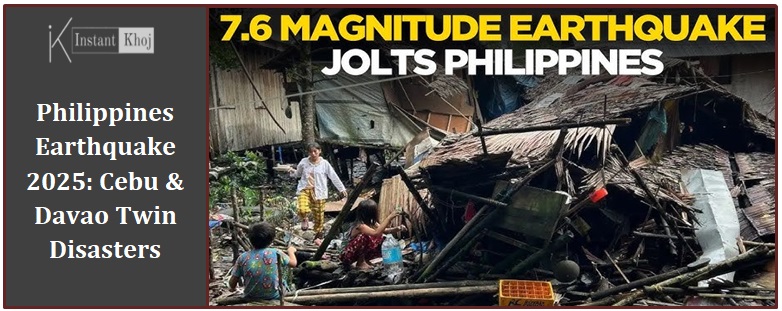Table of Content
In a short span, the Philippines was struck by two powerful earthquakes — one in the central region (Cebu) and another in the southern region (Mindanao / Davao). Both events highlighted the archipelago’s geologic vulnerability, the scale of human suffering, and the urgent need for preparedness and relief.
The Cebu Earthquake (September 30, 2025)
Date & time: September 30, 2025 at 21:59:43 PHT (Philippine Time)
Magnitude: 6.9 (moment magnitude scale)
Depth: Approx. 10 km (very shallow)
Epicenter / Fault: Offshore Cebu province; the quake is tied to the Bogo Bay Fault
Aftershocks: Over 10,000 small aftershocks recorded
Impact & Damage in Cebu / Visayas Region
- At least 74 people died, and over 1,000 injured.
- Many houses, churches, hospitals, and commercial buildings collapsed or were damaged.
- Landslides caused further destruction and trapped people.
- Power outages, road cracks, and major disruptions occurred.
- A tsunami warning was issued but later lifted.
Aftermath & Response
- Search and rescue teams deployed in Bogo, San Remigio, Daanbantayan, and Medellin.
- Thousands displaced; emergency shelters, food, and medical aid provided.
- Government and international agencies coordinated disaster relief and infrastructure repairs.
The Davao / Southern Philippines Earthquake (October 10, 2025)
Date & time: October 10, 2025 at 09:43 local time (01:43 UTC)
Magnitude: Initially reported as 7.6, later revised to 7.4
Depth: Around 23 km
Epicenter: Offshore the coast of Davao Oriental province; tied to the Philippine Trench
Impact & Damage in Davao / Mindanao Region
- At least one confirmed death and multiple injuries.
- Structural damage to hospitals, schools, bridges, and homes.
- Power outages and visible cracks in infrastructure.
- Seismic shaking felt even in Cebu and nearby islands.
Tsunami Alert & Sea Behavior
- Tsunami warnings issued for the Philippines, Indonesia, and Palau.
- Small wave fluctuations recorded; major threat later canceled.
Response & Government Action
- Evacuations ordered in coastal areas of Davao Oriental, Surigao del Sur, and Eastern Samar.
- National Disaster Risk Reduction and Management Council (NDRRMC) led coordination with defense, coast guard, and civil defense units.
- Relief operations and infrastructure repairs underway.
Why the Philippines Is So Prone to Earthquakes
The Philippines lies at the intersection of multiple tectonic plates in the Pacific Ring of Fire, a zone known for frequent earthquakes and volcanic activity. Subduction zones and faults like the Philippine Trench cause stress accumulation and eventual ruptures.
- Shallow quakes cause severe surface damage.
- Archipelagic geography increases tsunami risk.
What’s Next & Ongoing Challenges
- Damage assessment and reconstruction will take weeks.
- Funding and aid from global partners are essential.
- Aftershock monitoring and safety remain top priorities.
- Need for stronger building codes and early warning systems.
- Provision for mental health and livelihood support for survivors.
FAQ — All the Key Questions Answered
How strong were the earthquakes?
Cebu quake: Magnitude 6.9 on September 30, 2025.
Davao quake: Magnitude 7.4 on October 10, 2025.
What areas were most affected?
Cebu and surrounding Visayas islands; Davao Oriental and parts of Mindanao.
How many casualties and damages confirmed?
Cebu: ~74 deaths, over 1,000 injuries.
Davao: 1–2 deaths, major infrastructure damage.
Was there a tsunami?
Yes — warnings raised after the Davao quake; later canceled.
Why does the Philippines face frequent quakes?
Location in the Ring of Fire with multiple active faults and subduction zones.
What should affected people do now?
Avoid unsafe structures, stay alert for aftershocks, follow government alerts, and assist in relief where possible.
What is the government doing?
Coordinated relief by NDRRMC, civil defense, and local agencies; infrastructure restoration and medical aid ongoing.
Could more earthquakes happen soon?
Yes, aftershocks are likely; continued caution advised.
Final Thoughts & Takeaway
The twin tragedies in Cebu and Davao remind us of the Philippines’ ongoing seismic vulnerability. While nature’s force is inevitable, preparedness, awareness, and community support can save lives and rebuild hope.
For residents: know your escape routes, stay updated with PHIVOLCS alerts, and prioritize safety above all.
Also Read:
Nurses Protect Newborns During 5.8 Earthquake in Assam
Strong 5.8 Earthquake Hits Guwahati; Tremors Felt Nearby Areas
Follow Blog’son Instantkhoj for more latest stories and trending topics.




